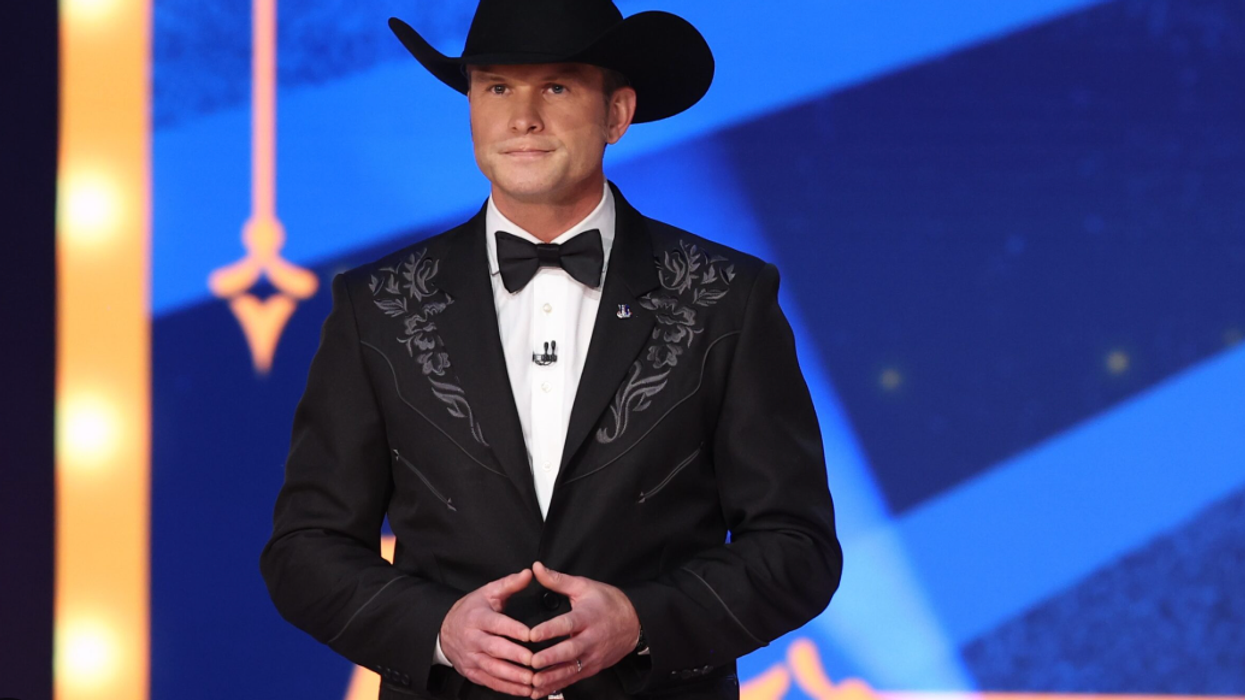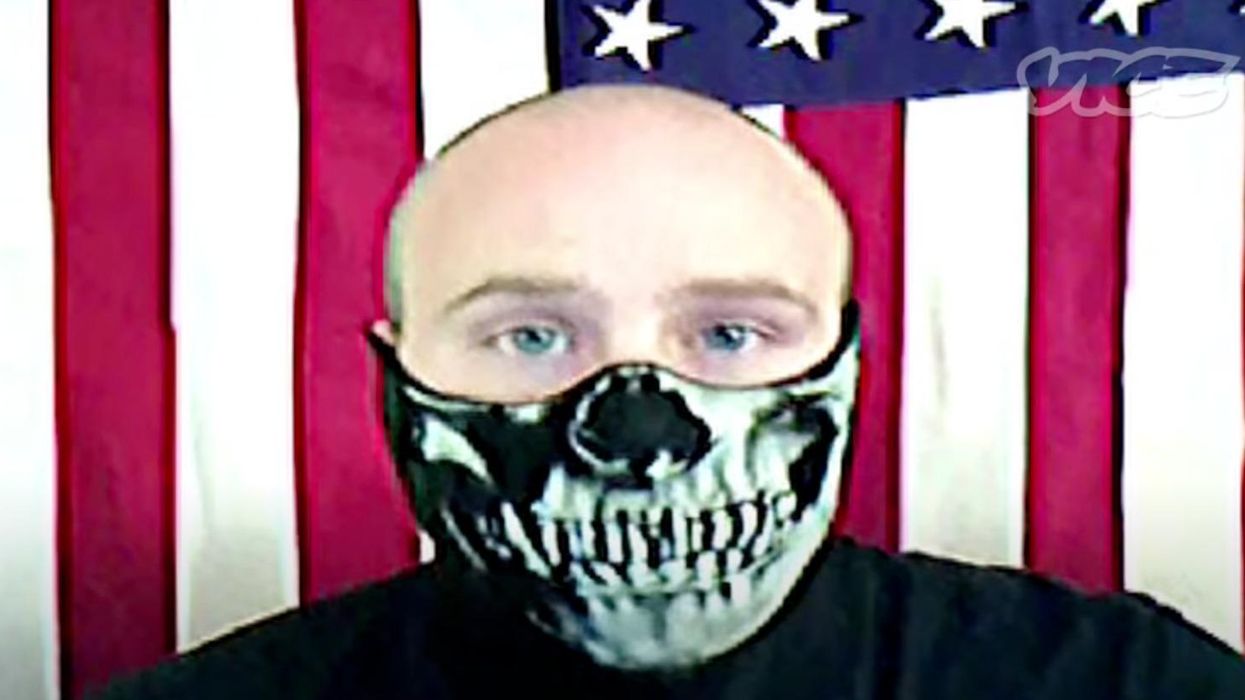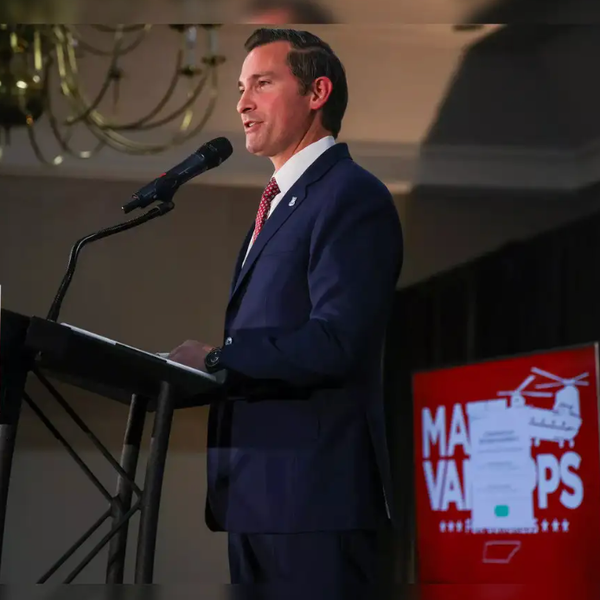The Marine’s name was Charles Dyer. He was an Iraq War combat veteran, and his videos began turning up in late 2008 and early 2009 on YouTube. I was monitoring the rapid increase in militia organizing that began occurring around the time Barack Obama began running for president, which then skyrocketed for the next four years. Dyer’s videos, which attracted hundreds of thousands of views, made me concerned—especially as I realized that he was a spokesman for this new organization that focused on recruiting military veterans into a far-right ideological army, and which was closely associated with the blossoming Tea Party movement.
Dyer’s videos, posted under his nom de guerre “July4Patriot,” comprised him ranting into a video camera about government “tyranny.” He wore his military uniforms—including his Marine dress uniform—but obscured his face with a skull mask (the first I had ever seen of them, well before they were adopted as the face covering of choice by alt-right neo-Nazis nearly a decade later).
He also had a fondness for “inspirational” anthemic music in the background, usually of the Celtic variety, and sometimes so loud it obscured what he was saying—but his incendiary, violent rhetoric was worrisome:
The enemies of the Constitution are not far away in some distant desert. They’re found right here on our own soil. We have become complacent. We have allowed the tyrants to take over this country, and we have no one to blame but ourselves. The time is now. We must rise up together and resist while we still have the ability resist.
This was stock rhetoric of the Patriot movement that I had been hearing since the 1990s. But most of the people indulging in this seditionist talk back then were ordinary citizens with little or no military background. On the other hand, Dyer not only had such a background, but claimed that there was an active antigovernment “resistance” within the armed forces:
I know many of you are afraid of the government. You wonder how you will fight something as strong as the U.S. military. I ask you this question: Who is that’s behind those rifles you fear? They are your sons, your daughters, your mothers and your fathers. They are American citizens just like you. And let me assure you that there is a resistance within the military. We will not be silent, we will not obey, we will not allow the American people to have their rights taken away in any manner. We will not disarm the American people during martial law. Let me assure you, Patriots, that we will die fighting our brothers in arms if we must, but we will not fight our countrymen.
As he posted more videos, Dyer’s rhetoric began ratcheting up the violence. What particularly sent him over the edge was the wave of outrage whipped up by right-wing media and conservative pundits over a bulletin issued by the Department of Homeland Security in early 2009 warning that right-wing extremists planned to be recruiting military veterans like himself into their ranks.
The bulletin, as was clear back then to anyone looking at domestic terrorism seriously, was an appropriate warning due to longstanding concerns about far-right infiltration of the ranks of the military, as well as recruitment of veterans into extremist ideologies and organizations after they returned home. People like Charles Dyer.
But right-wing pundits like Michelle Malkin and Glenn Beck began shrieking at the tops of their lungs that the bulletin was part of an Obama administration conspiracy to designate all conservatives far-right terrorists so they could begin rounding them up and imprisoning them. Bill O’Reilly and Sean Hannity joined in the bashing, as did a number of veterans groups like the American Legion, all of it handily whitewashing away the very real record of right-wing domestic terrorism in the United States.
All of this fueled and justified the anger of people like Dyer, who was furious about the bulletin:
They are already desperate to keep us from fighting back. The DHS has even issued a letter labeling Patriots as traitors, calling us right-wing extremists and domestic terrorists. Call me whatever name makes you feel justified in persecuting me. But should I care what men made of pure evil think, or label me as? Should I compromise my principles or make a whore of myself for these piece of filth? I think not.
But with the DHS blatantly calling Patriots, veterans, and constitutionalists a threat, all that I have to say is: You’re damn right we’re a threat. We’re a threat to anyone that endangers our rights and the Constitution of this republic.
“Patriots, we are not overpowered. If we united under one banner and fight for our children’s liberty and the constitution, our resolve is invincible to any standing army,” Dyer said in another video.
In one video showing him participating in paramilitary exercises, he answers someone who asks him whether he would advise signing up for the armed forces. “Join the military?” said Dyer. “Depends on what you want to do with it. Me? I'm going to use my training and become one of those domestic terrorists that you’re so afraid of from the DHS reports.”
Comments left behind on his YouTube channel were almost uniformly sympathetic and indicated that he had a significant audience for this rhetoric:
“This Marine is right on. Those now in power in Washington are hell-bent on destroying America and The Constitution. The Marine is right, America is a Republic, NOT a democracy, and what he says about laws that infringe on the 2nd Amendment is right. Any law that 'infringes' on the right to keep and bear arms is unconstitutional. This Marine is a patriot. Those that disagree with him, you know where the border is.”
“You only wish that's what he was. Everything he said in that video is true. And if you weren't so blind to what is going on right now, ie. the government wanting to nationalize the banking systems, wanting to increase gun laws ... not that there aren't over 20k already on the books, I could continue. The American people aren't free anymore, they just have a false sense of freedom, given to them to keep them complacent and happy as they go about their daily lives ... but soon that will end.”
“I believe there is a mountain of truth to this video. Everyone I know is stocking up on guns/ammo/food. I was in the military and I think most servicemembers feel the same as him. They took the oath to protect and defend the constitution against all enemies foreign and domestic. Most military members are very patriotic and attuned to what is going on. When I was in, most everyone hated Clinton. I can only imagine what they feel toward Obama and the Congress.”
In reality there were good reasons to be concerned about the radicalization of American veterans: In the 1990s, both Oklahoma City bomber Timothy McVeigh and Atlanta Olympics bomber Eric Rudolph had manifested the danger when radicalized extremists also possess military training and capabilities. In 2008 the FBI had issued its own internal report exploring the problem. It concluded:
- Although individuals with military backgrounds constitute a small percentage of white supremacist extremists, they frequently occupy leadership roles within extremist groups and their involvement has the potential to reinvigorate an extremist movement suffering from loss of leadership and in-fighting during the post-9/11 period.
- … Military experience—ranging from failure at basic training to success in special operations forces—is found throughout the white supremacist extremist movement. FBI reporting indicates extremist leaders have historically favored recruiting active and former military personnel for their knowledge of firearms, explosives, and tactical skills and their access to weapons and intelligence in preparation for an anticipated war against the federal government, Jews, and people of color.
- ... The prestige which the extremist movement bestows upon members with military experience grants them the potential for influence beyond their numbers. Most extremist groups have some members with military experience, and those with military experience often hold positions of authority within the groups to which they belong.
- ... Military experience—often regardless of its length or type—distinguishes one within the extremist movement. While those with military backgrounds constitute a small percentage of white supremacist extremists, FBI investigations indicate they frequently have higher profiles within the movement, including recruitment and leadership roles.
- ... New groups led or significantly populated by military veterans could very likely pursue more operationally minded agendas with greater tactical confidence. In addition, the military training veterans bring to the movement and their potential to pass this training on to others can increase the ability of lone offenders to carry out violence from the movement’s fringes.
However, the projection-fueled hysteria over the Homeland Security bulletin focused precisely on this problem became so overwhelming that Department of Homeland Security (DHS) Secretary Janet Napolitano was forced to issue an apology and retract the bulletin. The consequences went much deeper, of course: DHS’ domestic-terrorism-monitoring section was gutted, and the Obama administration fell into hunker-down/failure mode when it came to the radical right. Even more consequentially, these failures led to the ability of far-right extremists to keep festering and recruiting and growing. Especially groups like the Oath Keepers.
Dyer revealed his identity for the first time at a Tea Party event in Broken Arrow, Oklahoma, on July 4, 2009, where he gave a speech that promptly showed up online. It was advertised as an appearance by “July4Patriot,” but he told the audience his real name. He also told them the name of the organization for whom he was speaking and recruiting: the Oath Keepers.
In his speech, Dyer also described the “10 orders we will not obey”—the Oath Keepers’ original credo, a list of the kinds of actions used by authoritarian states—rounding up people, ordering the entire populace to be forcibly disarmed, imposing martial law, creating concentration camps—which mostly reflected the paranoid fears of black helicopters and FEMA common among movement Patriots.
The Oath Keepers, in fact, had only been founded that March 2009 by a former aide to Congressman Ron Paul of Texas—himself a well-established wellspring of far-right extremism with a mainstream patina—named Elmer Stewart Rhodes. A Yale Law graduate with a smooth media demeanor, Rhodes began showing up on TV, ranging from an appearance with Chris Mathews on his MSNBC Hardball program to an honored spot at the 2010 Conservative Political Action Committee (CPAC) annual convention.
Dyer kept posting videos, but without the skull mask. They mostly showed him engaging in paramilitary training exercises in rural areas, apparently in Oklahoma. He voiced extreme agitation and paranoia about the DHS bulletin, which he claimed targeted veterans as domestic terrorists. Dyer also made his own affiliation with the Patriot movement explicit, and made it similarly clear that the Oath Keepers were part of that movement:
The Patriot movement is basically just all different kinds of organizations across the United States. You’re looking at militias, or maybe the American resistance movement, the umbrella organization, and you may have the Ohio militia or the Michigan militia or whatever, militias all over the place. Citizens militias like in San Diego. They’re all under the Patriot movement. And we’re trying to take back this republic, and restore this republic like it's supposed, like it was intended by our Founding Fathers.
Dyer’s rhetoric became increasingly seditionist, especially the talk about “a violent revolution”:
I’m not gonna be hiding from my command anymore, I’m sure not gonna be hiding from the ATF or hiding from the FBI, I’m not hiding from any organization. If they wanna come take me, I’m not gonna be afraid. If I’m afraid at that point, we’re in a tyrannical government in the first place, and people need to rise up. At that point, there needs to be a violent revolution.
This was part of a larger trend we were seeing elsewhere across the country, including in the West and the South, of people forming militias and conducting paramilitary exercises, and wielding threatening seditionist rhetoric without restraint. The numbers of militias in the United States began spiking from their mid-2000s low of 131 to 512 in 2009, eventually hitting an all-time high in 2011 at 1,360.
Dyer’s speeches and activism, meanwhile, were being heavily promoted at the Oath Keepers’ website through 2009. Dyer shed his pseudonym altogether and began simply using his real name.
However, Dyer’s career as a spokesman for the Oath Keepers ended abruptly and in ugly fashion. He was arrested in January 2010 and charged with raping his young daughter. Investigators found a grenade launcher in his home.
Rhodes promptly disavowed him, claiming that Dyer had never been an actual dues-paying, card-signing member of the Oath Keepers.
In fact, however, Rhodes and Dyer were working closely together for much of that year leading up to his arrest, according to Rhodes’ ex-wife, Tasha Adams. In my interview with her earlier this year, she described how Rhodes—enamored of Dyer’s videos—had taken the budding radical under his wing.
Adams says Dyer was recruited by Rhodes into the organization early on, and Rhodes began putting him to use as a spokesman at events like the one in Broken Arrow. Adams said that Rhodes became “obsessed” with Dyer (“Stewart used to talk with his mother all the time”), and “almost immediately invited him to our home.”
After having Dyer sleeping on their couch for several days, Adams found out that Dyer was under investigation for having molested his own young daughter, but “he didn’t stay much longer after that.” Shortly after he departed, Dyer in fact was charged with the crime and eventually convicted; he’s currently still serving his 30-year sentence.
“He had sort of an eerie vibe about him. Just his demeanor,” Adams said.
At the same time, Oath Keepers by 2010 had become a fixture on the Tea Party scene, becoming listed cosponsors of Tea Party gatherings and making their presence felt, and welcomed, among that movement. This corroborated what I had been seeing elsewhere: The Tea Party, marketed on Fox News and CNN and everywhere else as a nominally mainstream movement, was rapidly becoming a massive conduit for a revival of the ‘90s Patriot “militia” movement.
This trend became cemented over the following year, and eventually the Tea Party movement became wholly consumed by Patriot ideology, rhetoric, and agendas. And the Oath Keepers were one of the leading purveyors of that transformation.
Yet they continued to be treated as mainstream by the media, particularly right-wing outlets. Fox News and particularly Bill O’Reilly—where Rhodes began popping up with regularity—were eager to indulge Rhodes’ claims that his group really wasn’t a militia (even if they were functionaries of the same Patriot movement) and similarly eager to deny that militias had taken over the Tea Party.
Of course, O’Reilly and his Fox cohorts had also been among the leading voices claiming that Obama’s DHS was trying to smear conservatives and the Tea Party with accusations of domestic terrorism. This line of attack became broadly used by Republicans across the board to hammer into the narrative their denial that right-wing domestic terrorism posed any kind of real threat to Americans.
The end result of that narrative, after more than a decade of denial, was the Jan. 6 insurrection, when a mob of Donald Trump-loving Patriots attacked the U.S. Capitol and attempted to prevent Trump’s loss becoming manifest in the peaceful transfer of power. And it surprises no one who has watched the Oath Keepers over the years that Rhodes is now on trial for seditionist conspiracy for having attempted to lead that coup.
Rhodes has always attempted to present Oath Keepers as a mainstream organization, but the façade was thoroughly exposed in 2009 by Justine Sharrock at Mother Jones, whose in-depth report revealed a cadre of armed and angry extremists with paranoid ideas and unstable dispositions behind the claims of normalcy and civic-mindedness, with the patina of authority that having military and law enforcement veterans on your membership rolls can provide.
Dyer, in fact, was not an anomaly. He was the embodiment of the kind of people the Oath Keepers were built to attract: Only borderline stable, simmering with anger and paranoia, and underscored with a constant thrum of menace and potential violence. The kind of people who to this day comprise Trump’s MAGA army.












